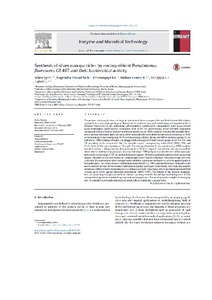Показать сокращенную информацию
Synthesis of silver nanoparticles by endosymbiont Pseudomonas fluorescens CA 417 and their bactericidal activity
| Автор | Baker, Syed | |
| Автор | Nagendra Prasad, M. N. | |
| Автор | Dhananjaya, B. L. | |
| Автор | Mohan, Kumar K. | |
| Автор | Yallappa, S. | |
| Автор | Satish, S. | |
| Дата внесения | 2018-02-07T07:30:09Z | |
| Дата, когда ресурс стал доступен | 2018-02-07T07:30:09Z | |
| Дата публикации | 2016-12 | |
| Библиографическое описание | Baker, Syed. Synthesis of silver nanoparticles by endosymbiont Pseudomonas fluorescens CA 417 and their bactericidal activity [Текст] / Syed Baker, M. N. Nagendra Prasad, B. L. Dhananjaya, Kumar K. Mohan, S. Yallappa, S. Satish // Enzyme and Microbial Technology. — 2016. — Т. 95. — С. 128-136 | |
| ISSN | 01410229 | |
| URI (для ссылок/цитирований) | http://www.sciencedirect.com/science/article/pii/S0141022916302010 | |
| URI (для ссылок/цитирований) | https://elib.sfu-kras.ru/handle/2311/69924 | |
| Описание | Текст статьи не публикуется в открытом доступе в соответствии с политикой журнала. | |
| Аннотация | tThe present study emphasizes on biogenic synthesis of silver nanoparticles and their bactericidal activityagainst human and phytopathogens. Nanoparticle synthesis was performed using endosymbiont Pseu-domonas fluorescens CA 417 inhabiting Coffea arabica L. Synthesized nanoparticles were characterizedusing hyphenated spectroscopic techniques such as UV–vis spectroscopy which revealed maximumabsorption 425 nm. Fourier transform infrared spectroscopy (FTIR) analysis revealed the possible func-tional groups mediating and stabilizing silver nanoparticles with predominant peaks occurring at 3346corresponding to hydroxyl group, 1635 corresponding carbonyl group and 680 to aromatic group. X-raydiffraction (XRD) analysis revealed the Bragg’s diffraction pattern with distinct peaks at 38◦44◦, 64◦and78◦revealing the face-centered cubic (fcc) metallic crystal corresponding to the (111), (200), (220) and(311) facets of the crystal planes at 2 angle. The energy dispersive X-ray spectroscopy (EDS) analysisrevealed presence of high intense absorption peak at 3 keV is a typical characteristic of nano-crystallinesilver which confirmed the presence of elemental silver. TEM analysis revealed the size of the nanopar-ticles to be in the range 5–50 nm with polydisperse nature of synthesized nanoparticles bearing myriadshapes. The particle size determined by Dynamic light scattering (DLS) method revealed average size to be20.66 nm. The synthesized silver nanoparticles exhibited significant antibacterial activity against panel oftest pathogens. The results showed Klebsiella pneumoniae (MTCC 7407) and Xanthomonas campestris to bemore sensitive among the test human pathogen and phyto-pathogen respectively. The study also reportssynergistic effect of silver nanoparticles in combination with kanamycin which displayed increased foldactivity up to 58.3% against Klebsiella pneumoniae (MTCC 7407). The results of the present investiga-tion are promising enough and attribute towards growing scientific knowledge on development of newantimicrobial agents to combat drug resistant microorganisms. The study provides insight on emergingrole of endophytes towards reduction of metal salts to synthesize nanoparticles. | |
| Тема | Endosymbiont | |
| Тема | Silver nanoparticles | |
| Тема | Pseudomonas fluorescens CA 417 | |
| Тема | Coffea arabica L | |
| Тема | Antibacterial activity | |
| Тема | Kanamycin | |
| Название | Synthesis of silver nanoparticles by endosymbiont Pseudomonas fluorescens CA 417 and their bactericidal activity | |
| Тип | Journal Article | |
| Тип | Journal Article Preprint | |
| Страницы | 128-136 | |
| ГРНТИ | 34.27 | |
| Дата обновления | 2018-02-07T07:30:09Z | |
| DOI | 10.1016/j.enzmictec.2016.10.004 | |
| Институт | Институт фундаментальной биологии и биотехнологии | |
| Подразделение | Базовая кафедра биотехнологии | |
| Журнал | Enzyme and Microbial Technology | |
| Квартиль журнала в Scopus | Q2 | |
| Квартиль журнала в Web of Science | Q2 |

